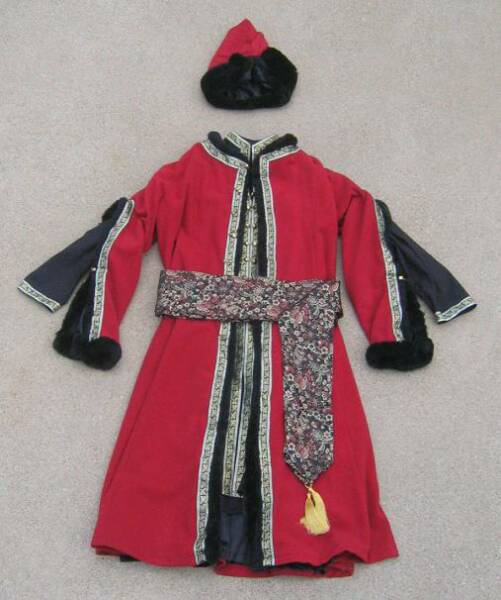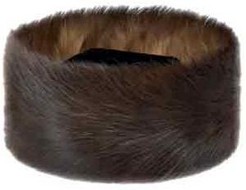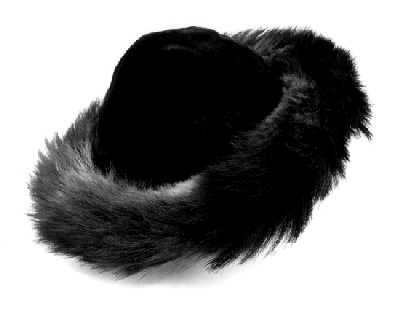|
|
Post by pjotr on Mar 13, 2012 20:21:49 GMT 1
|
|
|
|
Post by Bonobo on Mar 13, 2012 22:06:34 GMT 1
I have no idea and need explanation.        I only know this coat they wear is called cha³at in Polish. Do you know I used to wear a cha³at in the primary school in 1970s? ;D ;D ;D ;D ;D ;D |
|
|
|
Post by pjotr on Mar 15, 2012 22:07:45 GMT 1
Hasidic dressWithin the Hasidic world, one can distinguish different Hasidic groups by subtle differences in dress. Some details of their dress are shared by non-Hasidic Haredim. Much of Hasidic dress was historically the clothing of all Eastern-European Jews, but Hasidim have preserved more of these styles to the present day. Furthermore, Hasidim have attributed religious origins to specific Hasidic items of clothing. Contrary to popular belief, Hasidic dress has little to do with the way Polish nobles once dressed. (The Emancipation movement probably started this myth in the late 19th century in an attempt to induce younger Jews to abandon the outfit.) Interestingly, secular Yiddish writers of old, living in Eastern Europe ( Sholom Aleichem, for example) appear to have no knowledge of the " Polish origin" of the dress. Likewise, numerous Slavic sources from the 15th century onwards refer to the " Jewish kaftan". The Tsarist edict of the mid-19th century banning Jewish clothing mentions the " Jewish kaftan" and the " Jewish hat" and, as a result of this edict, Hasidim modified their dress in the Russian Empire and generally hid their sidelocks. Modern Chabad Lubavitch wear the Prince Albert frock coat substitutes for the bekishe reflecting this change, while many Polish Hasidim do so by wearing a redesigned shtreimel sometimes known as a spodik.  Ultra-orthodox men wearing a shtreimel Ultra-orthodox men wearing a shtreimel A young man wearing a spodik A young man wearing a spodik The Prince Albert frock coat The Prince Albert frock coat A bekishe, or beketshe (Yiddish: בעקעטשע), is a long coat, usually made of black silk or polyester worn by Hasidic Jews, and by some non-Hasidic Haredi Jews.Hasidic dress A bekishe, or beketshe (Yiddish: בעקעטשע), is a long coat, usually made of black silk or polyester worn by Hasidic Jews, and by some non-Hasidic Haredi Jews.Hasidic dress did change over the last hundred years, and became more European in response to the Emancipation Movement. Modern Hasidim tend to wear Hasidic dress as worn just prior to World War II. The classical oriental outfit consists of the kaftan, white undershirt, sash, knee-breeches (halbe-hoyzn), white socks and slippers (shtibblat). This outfit allegedly had a Babylonian origin before its later adoption by Jews, Persians and lastly the Turks, who brought it to Europe. The Polish nobility adopted its 16th century outfit from the Turks, hence (allegedly) the similarity between the Hasidic outfit and Polish nobles' clothing. (Similarly, Hasidic dress has a vague connection with Shia Muslim clerical dress, the Shia clergy adopted this dress from the Persians.) One Hasidic belief (taught by the Klausenberger rebbe) holds that Jews originally invented this dress code and that the Babylonians adopted it from Jews during the Jewish exile in Babylon of the 6th century BCE. This belief is not widely held or even well known among Hasidim.  Szlachta in the 16th-17th century. Szlachta in the 16th-17th century. Polish Noble Costume from 1683 Polish Noble Costume from 1683 A Polish nobel man with a shtreimel or spodik A Polish nobel man with a shtreimel or spodik
|
|
|
|
Post by chussidl on Feb 2, 2014 19:10:06 GMT 1
With regard to the fur hats, you should take a look at Russian crowns, the earliest of which is if I recall correctly 14th century. It was a gift from the Great Khan of the Mongols to his Muskovite brother-in-law. This appears to have ben copied by the nobility, and later by their Jewish agents who managed their estates, and was thus a status symbol. Hassidim wore it as a prestigious headdress to honour he sabbath. Perhaps that usage predates the hassidim, but has only been perpetuated by them.
Its use in Poland is also borrowed, because Hasidism actually started life in Podolia and Volhyn, where Russian/Muskovite was prevalent, or became prevalent. It only later spread West into Poland.
So the history of the modern hassidic 'shtraaml' (that's how the word was pronounced in Poland) goes back to the regular Mongol headdress that they still wear today. and actually incorporates quite a lot of the history of the area.
Incidentally, the name itself comes from the ring of fur, known as a Shtraam. If anyone can develop that further - eg where does that word come from - I be grateful.
|
|
|
|
Post by jeanne on Feb 2, 2014 20:23:55 GMT 1
I can't add any information to the discussion, but I do thank you for an interesting post!
|
|
|
|
Post by pjotr on Feb 3, 2014 18:24:51 GMT 1
Chussidl, I asked your question on another forum about Judaism, and I got two replies: IwishiwerethinSenior MemberI would think its origin would be Russian. Just a guess. PruzhanySenior MemberThe hassidic ' shtraaml' is probably Shtreimel in Yiddish.  A shtreimel (Yiddish: שטרײַמל, pl. שטרײַמלעך shtreimlech) is a fur hat worn by many married haredi Jewish men, particularly (although not exclusively) members of Hasidic groups, on Shabbat and Jewish holidays and other festive occasions. In Jerusalem, the shtreimel is also worn by " Yerushalmi" Jews (non-Hasidim who belong to the original Ashkenazi community of Jerusalem, also known as Perushim). The shtreimel is generally worn only after marriage, except in some Yerushalmi communities, where boys wear it from the age of bar mitzvah.  A further story I read was that in Russia Jews wrapped fur tails around their kippot that they remain unrecognized in the public and couldn't be identified as Jews. A further story I read was that in Russia Jews wrapped fur tails around their kippot that they remain unrecognized in the public and couldn't be identified as Jews.I hope this anwsers your question. Cheers, Pieter |
|
|
|
Post by chussidl on Feb 5, 2014 14:19:54 GMT 1
Hi Pruzhany: The spellings reflect various dialects. In the areas where it was worn (ie in Podolia and Volhynia (Ukraine) it was pronounced 'shtraaml'. 'Shtreimel' is the Standard Yiddish way of pronouncing the word. It is based on Lithuanian Yiddish where they were not worn, the people who created that version of the language do not wear them either.
Hi Pieter
The lower photo depicts an authentic shtraaml, as worn in the Ukraine, and more recently (but not today) in Jerusalem. Note it's high centre-piece (called the verech = wierch) and relatively narrow and sparse rim of fur, very similar to the Russian crown (http://chemico-group.com/index.php?option=com_content&view=article&id=102&Itemid=231) - minus the cross!
The fur rim is unlike that of the crowns in one respect: it is made of made of multiple sabel tails (whreas the rim around the crown is one piece. The very oldest pictures show only a dozen or so such tails - the number varies - but by the early 1800's at the latest, a lot more were used. Since the war, the number and thickness (from top to bottom) has been increasing every decade or so. The top picture is a modern stylised version (about ten years old). Modern manufacturers don't understand the symbolism behind the older construction and have literally turned it upside down, with the centre-piece lower than the fur. YUK!
The story about wrapping the fur around their hats (that we call kappel or yarmylke) I find rather far-fetched, as the rest of their dress would give them away. Yet another myth has it that Jews were forced to wear animal tails on their heads as a humiliation, but we find no record of such a thing ever happening, or even who would force them to do that. The Polish kings and nobility actually always had very good relations with the Jews (it was the German - Volkdeutsche - burghers in the towns and their cohorts in the clergy who created anti-Semitism in Poland for economic reasons).
|
|
|
|
Post by pruzhany on Feb 10, 2014 17:43:47 GMT 1
FWIW I wasn't quoted from the other forum. I simply gave the user some links to read and the poster copied and pasted from those links. But IMHO if you're going to follow through with this thread then you will need to look past present day Poland at the parts stolen by Russia to create Ukraine and Belarus. Hence my handle which was a Polish town that now sits in Belarus. In my opinion, I think current Hasidics where it as a a crown to make themselves look for pious than they really are (compared to the Hasidics that existed before WW2). en.wikipedia.org/wiki/Shtreimel |
|
|
|
Post by pjotr on Oct 14, 2015 23:18:16 GMT 1
www.joodseomroep.nl/zoek-de-verschillen-2/ Press on the video 'Zoek de verschillen'. If you scroll through it you see a 27 year old Dutch secular jewish woman who is a Philosophy student and who has a Roman-Catholic Dutch boyfriend. She visits the Chassidic New York community in Brooklyn heights. She is critical and has some differences of opinion with these Chassidic people:
|
|